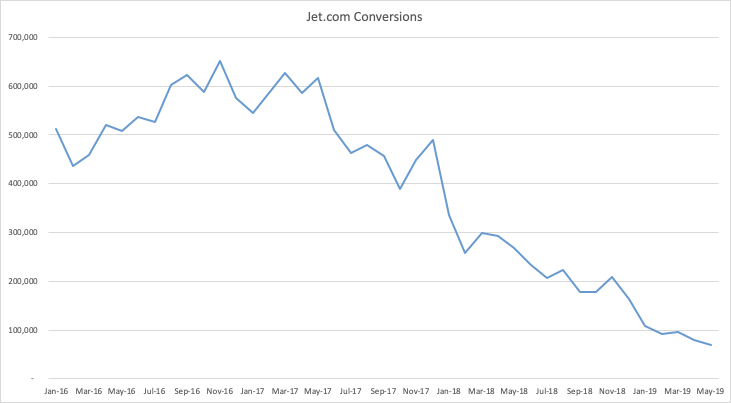Walmart made headlines last week by announcing that it would fold Jet.com into its Walmart ecommerce operations, less than three years after the $3.3 billion acquisition.
But, in fact, a closer look at the performance of both sites’ leads reveals:
- This shouldn’t be a surprise, because this has been Walmart’s plan all along, and
- Despite what the headlines say, this is primarily a win for Walmart despite the large acquisition price.
We’ll tell this story with two simple charts. Apologies in advance for over-doing the aviation metaphors. I couldn’t help myself. As the kids say, “Sorry. Not sorry.”
1. Jet’s transactions are way down
The number of transactions on Jet.com rose to more than 600,000 a month in early 2017 but has been on a precipitous decline since then, shrinking to less than 100,000 a month. They don’t even exhibit the holiday-shopping spikes nearly every other retailer exhibits.
A drop like this doesn’t happen by accident, not in a world where Walmart reports that its ecommerce sales were up 37 percent in Q1. Or, after the ecommerce marketplace as a whole has grown steadily since, well, the start of ecommerce. Or, where spending power among affluent urbanites (Jet.com’s supposed strength) continues to rise as economic bifurcation enters its fourth decade. There is a long list of contextual reasons why a rising tide (tailwinds?) should be lifting Jet.com. Because of this, its loss of altitude is even more surprising and stark.

Source: Jumpshot
2. Jet.com’s ecommerce fuel, paid search, is also way down
Jet.com is one a handful of ecommerce sites, along with Chewy.com and Wayfair.com, to have successfully bought their growth. Largely this means paying for placement on Google’s search engine results pages, and it’s an increasingly effective strategy. Paid click-through rates on Google are up, particularly for companies willing to spend on expensive awareness-building campaigns across media channels. Consumers simply feel more comfortable clicking on those paid links when they recognize the brand.
Paid search kept Jet.com’s internet traffic aloft. And it has tumbled almost in lockstep with Jet.com’s sales. You could argue that Jet.com’s sales may have fallen for any number of reasons. But there’s only one reason why their paid search traffic went from eight million visitors a month to less than one million: Walmart was reallocating its budget elsewhere. Growing sales on Jet.com simply wasn’t a priority for the retail giant.

Source: Jumpshot
The Jet brand and the Jet/Walmart fit remain indistinct
Walmart has pulled back on making Jet a public-facing brand in part because of an ill-defined fit between the two brands. Jet was initially created to reach consumers who cared more about value than convenience. It was designed to be sort of an online Costco, offering very low prices to those willing to pay a membership fee. This would seemingly be a good fit for Walmart, whose growth has come via an unwavering commitment to its brand promise (everyday low prices) and core target (value-oriented non-urban consumers). But over time, Jet morphed into a brand with a reputation of reaching younger, more affluent urbanites – not an existing fit with Walmart, but a potentially complementary one that could help Walmart grow beyond its core.
While either strategy can be reasonable, the Walmart/Jet fit seemed to vacillate between the two, and never really settled on either. Jet has upscale ambitions, but its appeal to affluent consumers may be overstated. In Q1 2019, the top three keyword searches on Jet.com were decidedly mainstream “toilet paper”, “paper towels”, and “Frito-Lay”. It’s not until the fourth keyword search term, “mid-century modern furniture”, that the searches take a more upscale vibe.
Walmart has been toning down its positioning of Jet.com as an urban growth engine, and its discussion of Jet’s role has become increasingly circumscribed. As Walmart put it,
“Last year, we repositioned the Jet site itself. Across most of the country, we saw we could get a much higher return on our marketing investments with Walmart.com, so we’ve dialed up our marketing spend there… However, in specific large cities where Walmart has few or no stores, Jet has become hyper-focused on those urban customers…. The focus has largely been on New York so far, and we’re looking at other cities.”
Walmart’s real motivation in buying Jet.com
The fact is that this acquisition was never about adding new customers or reaching complementary markets. Instead, it was part tech-buy, part acqui-hire. Walmart wanted technology innovations like Jet.com’s real-time pricing algorithm, which helps increase revenue per customer. And while Walmart announced that Simon Belsham, Jet.com’s current president, will leave later this summer, it still has the person they really wanted: Jet.com’s founder Marc Lore, who will continue to run Walmart’s ecommerce business. Lore is widely considered to have led Walmart’s recent overall ecommerce growth, including improvements in operations, infrastructure, and supply chain.
The Jet.com acquisition remains a win for Walmart
Ultimately it’s hard to argue with results. Walmart’s ecommerce sales are up significantly. Its extensive network of stores bodes well in the omnichannel future. Amazon has extended beyond its affluent base to build extensive middle-class appeal but hasn’t penetrated strongly into Walmart’s base. And while Walmart is a distant second to Amazon online, Walmart is far ahead of the other retailers behind it.
Many headlines will try to position Jet.com’s incorporation into the Walmart mothership as a failure. But a deeper analysis reveals that the acquisition continues to go as Walmart planned, and is largely a win for the Arkansas-based retailer.
Stephen Kraus is the head of digital insights for Jumpshot. Kraus is an expert in consumer insights and digital trends, the author of three books and holds a Ph.D. from Harvard University.
The post Decommissioning Jet: Two charts proving Walmart planned to ground Jet all along appeared first on Search Engine Watch.
from Search Engine Watch https://ift.tt/2LlzKQ8
Comments
Post a Comment